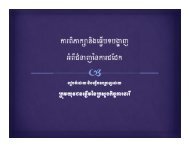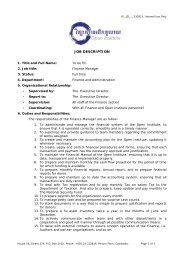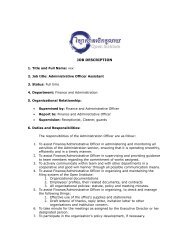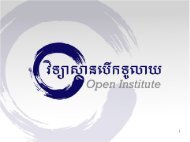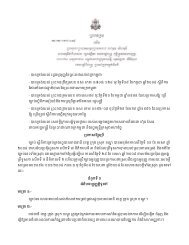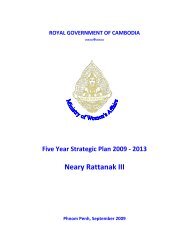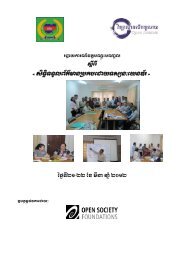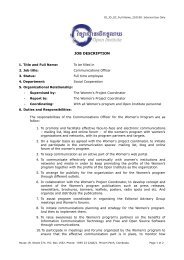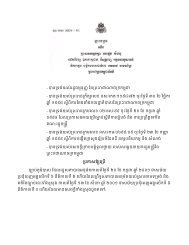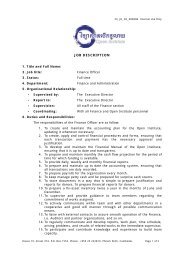Education Education An approach to some basic Indicators for ...
Education Education An approach to some basic Indicators for ...
Education Education An approach to some basic Indicators for ...
Create successful ePaper yourself
Turn your PDF publications into a flip-book with our unique Google optimized e-Paper software.
Catalog of indica<strong>to</strong>rs Introduction 5 The inclusion of gender perspective in indica<strong>to</strong>rs with socio-demographic characteristics letsus evaluate not only the actions taken in regards of the population itself (<strong>for</strong> example thepopulation policies), but also <strong>to</strong> understand how the rest of the policies and strategies focuson the population depending on determined characteristics, and their adequate design interms of covering all social needs.As we have seen though our research, in Cambodia <strong>some</strong> demographic data is collectedthrough census and other special studies. In terms of statistics, it needs <strong>to</strong> be said that in thelast years there has been a great progress in the collection and production of demographicstatistics in the country.The following figure enumerates the list of demographic indica<strong>to</strong>rs that have been included inthe catalogue:1. Sex ratio by age group 6. Population distribution withineach sex, by location (urban/rural)2. Population distribution within eachsex, by civil status7. Crude Birth rate by sex3. Population by ethno-culturalcharacteristic4. Person with disability rate by sexand type of disability5. Total fertility rate8. Distribution of local migrationby sex and location9. Mean age of mother at firstchild birth1.3.2. <strong>Education</strong> sec<strong>to</strong>r<strong>Education</strong> is one of the key development sec<strong>to</strong>rs <strong>for</strong> progress <strong>to</strong>ward socio-economic wellbeing.Indica<strong>to</strong>rs of gender-integrated education are crucially important <strong>for</strong> measuringdeficiencies in the gender gap.<strong>Education</strong> is intimately linked <strong>to</strong> the economy, the labor market and social status; in thissense, it can be said that education opportunities have direct effects on equality and, ingeneral, on distribution of social opportunities. Both <strong>for</strong>mal and in<strong>for</strong>mal education can fulfillan essential labor regarding the reduction and elimination of gender gaps in every ambit.<strong>Education</strong> is a driver <strong>for</strong> social, economic, political advancement, and ultimately a <strong>to</strong>ol <strong>for</strong>development and empowerment. Improved living conditions and poverty reduction are issuesclosely linked <strong>to</strong> education, hence the ef<strong>for</strong>ts and work <strong>to</strong> generate an equitable high-qualityuniversal education. National policies and international intervention spend much of theirbudgets on education, mostly on ensuring access (especially in the early levels). One of theMillennium Development Goals (MDGs) refers <strong>to</strong> universal access.




